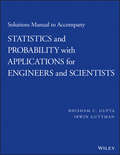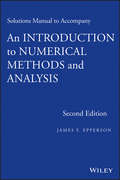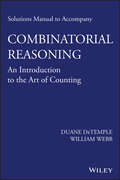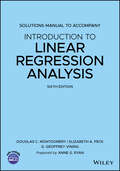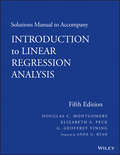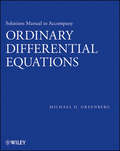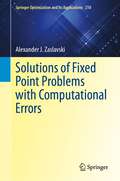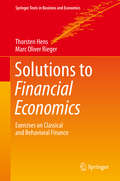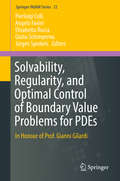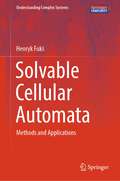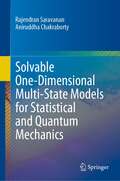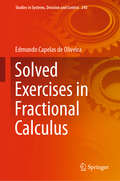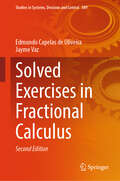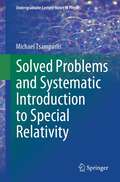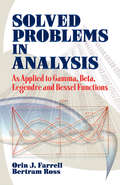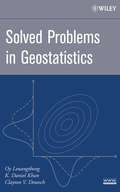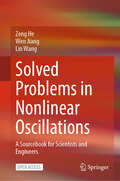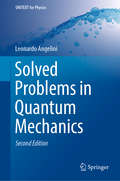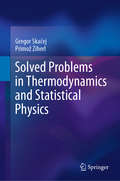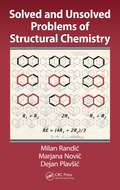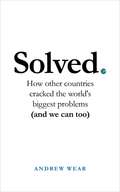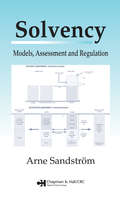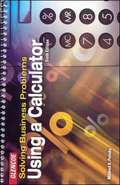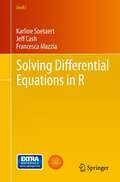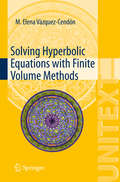- Table View
- List View
Solutions Manual to Accompany Statistics and Probability with Applications for Engineers and Scientists
by Bhisham C. Gupta Irwin GuttmanA solutions manual to accompany Statistics and Probability with Applications for Engineers and ScientistsUnique among books of this kind, Statistics and Probability with Applications for Engineers and Scientists covers descriptive statistics first, then goes on to discuss the fundamentals of probability theory. Along with case studies, examples, and real-world data sets, the book incorporates clear instructions on how to use the statistical packages Minitab® and Microsoft® Office Excel® to analyze various data sets. The book also features:Detailed discussions on sampling distributions, statistical estimation of population parameters, hypothesis testing, reliability theory, statistical quality control including Phase I and Phase II control charts, and process capability indicesA clear presentation of nonparametric methods and simple and multiple linear regression methods, as well as a brief discussion on logistic regression methodComprehensive guidance on the design of experiments, including randomized block designs, one- and two-way layout designs, Latin square designs, random effects and mixed effects models, factorial and fractional factorial designs, and response surface methodologyA companion website containing data sets for Minitab and Microsoft Office Excel, as well as JMP ® routines and resultsAssuming no background in probability and statistics, Statistics and Probability with Applications for Engineers and Scientists features a unique, yet tried-and-true, approach that is ideal for all undergraduate students as well as statistical practitioners who analyze and illustrate real-world data in engineering and the natural sciences.
Solutions Manual to accompany An Introduction to Numerical Methods and Analysis
by James F. EppersonA solutions manual to accompany An Introduction to Numerical Methods and Analysis, Second Edition An Introduction to Numerical Methods and Analysis, Second Edition reflects the latest trends in the field, includes new material and revised exercises, and offers a unique emphasis on applications. The author clearly explains how to both construct and evaluate approximations for accuracy and performance, which are key skills in a variety of fields. A wide range of higher-level methods and solutions, including new topics such as the roots of polynomials, spectral collocation, finite element ideas, and Clenshaw-Curtis quadrature, are presented from an introductory perspective, and theSecond Edition also features: Chapters and sections that begin with basic, elementary material followed by gradual coverage of more advanced material Exercises ranging from simple hand computations to challenging derivations and minor proofs to programming exercises Widespread exposure and utilization of MATLAB® An appendix that contains proofs of various theorems and other material
Solutions Manual to accompany Combinatorial Reasoning: An Introduction to the Art of Counting
by William Webb Duane DetempleThis is a solutions manual to accompany CombinatorialReasoning: An Introduction to the Art of Counting Written by well-known scholars in the field, CombinatorialReasoning: An Introduction to the Art ofCounting introduces combinatorics alongside moderntechniques, showcases the interdisciplinary aspects of the topic,and illustrates how to problem solve with a multitude of exercisesthroughout. The authors' approach is very reader-friendly andavoids the "scholarly tone" found in many books on this topic.
Solutions Manual to accompany Introduction to Linear Regression Analysis
by Douglas C. Montgomery Elizabeth A. Peck G. Geoffrey ViningINTRODUCTION TO LINEAR REGRESSION ANALYSIS
Solutions Manual to accompany Introduction to Linear Regression Analysis (Wiley Series In Probability And Statistics Ser. #821)
by Douglas C. Montgomery Elizabeth A. Peck G. Geoffrey ViningAs the Solutions Manual, this book is meant to accompany the main title, Introduction to Linear Regression Analysis, Fifth Edition. Clearly balancing theory with applications, this book describes both the conventional and less common uses of linear regression in the practical context of today's mathematical and scientific research. Beginning with a general introduction to regression modeling, including typical applications, the book then outlines a host of technical tools that form the linear regression analytical arsenal, including: basic inference procedures and introductory aspects of model adequacy checking; how transformations and weighted least squares can be used to resolve problems of model inadequacy; how to deal with influential observations; and polynomial regression models and their variations. The book also includes material on regression models with autocorrelated errors, bootstrapping regression estimates, classification and regression trees, and regression model validation.
Solutions Manual to accompany Ordinary Differential Equations
by Michael D. GreenbergFeatures a balance between theory, proofs, and examples and provides applications across diverse fields of study Ordinary Differential Equations presents a thorough discussion of first-order differential equations and progresses to equations of higher order.
Solutions of Fixed Point Problems with Computational Errors (Springer Optimization and Its Applications #210)
by Alexander J. ZaslavskiThe book is devoted to the study of approximate solutions of fixed point problems in the presence of computational errors. It begins with a study of approximate solutions of star-shaped feasibility problems in the presence of perturbations. The goal is to show the convergence of algorithms, which are known as important tools for solving convex feasibility problems and common fixed point problems.The text also presents studies of algorithms based on unions of nonexpansive maps, inconsistent convex feasibility problems, and split common fixed point problems. A number of algorithms are considered for solving convex feasibility problems and common fixed point problems. The book will be of interest for researchers and engineers working in optimization, numerical analysis, and fixed point theory. It also can be useful in preparation courses for graduate students. The main feature of the book which appeals specifically to this audience is the study of the influence of computational errorsfor several important algorithms used for nonconvex feasibility problems.
Solutions to Financial Economics: Exercises on Classical and Behavioral Finance (Springer Texts in Business and Economics)
by Thorsten Hens Marc Oliver RiegerThis book offers a concise introduction to the field of financial economics and presents, for the first time, recentbehavioral finance research findings that help us to understand many puzzles in traditional finance. Tailor-made formaster’s and PhD students, it includes tests and exercises that enable students to keep track of their progress. Parts of the book can also be used at the bachelor level.
Solvability, Regularity, and Optimal Control of Boundary Value Problems for PDEs
by Angelo Favini Pierluigi Colli Elisabetta Rocca Giulio Schimperna Jürgen SprekelsThis volume gathers contributions in the field of partial differential equations, with a focus on mathematical models in phase transitions, complex fluids and thermomechanics. These contributions are dedicated to Professor Gianni Gilardi on the occasion of his 70th birthday. It particularly develops the following thematic areas: nonlinear dynamic and stationary equations; well-posedness of initial and boundary value problems for systems of PDEs; regularity properties for the solutions; optimal control problems and optimality conditions; feedback stabilization and stability results. Most of the articles are presented in a self-contained manner, and describe new achievements and/or the state of the art in their line of research, providing interested readers with an overview of recent advances and future research directions in PDEs.
Solvable Cellular Automata: Methods and Applications (Understanding Complex Systems)
by Henryk FukśThe main focus of the book is solvability of cellular automata, that is, expressing the state of a given cell after a given number of steps by an explicit formula. The author considers solutions of two types of initial value problems for cellular automata, the deterministic one and the probabilistic one. In the first chapter the basic concepts of cellular automata theory are introduced. Deterministic initial value problem is introduced next and solutions for selected simple rules are also presented. In the following chapters various techniques for solving the deterministic problem are introduced, using elementary CA rules of increasing complexity as examples. The second part of the book introduces the concept of probability measure in the context of cellular automata and the probabilistic initial value problem for both deterministic and probabilistic rules. The book is amply illustrated with examples and applications such as the density classification problem, phase transitions in traffic models or the diffusion of innovations model. In the appendix, solution formulae (both deterministic and probabilistic) for over 60 elementary cellular automata rules are listed. Ruelle-Frobenius-Perron equations for all 88 minimal elementary cellular automata are also provided.
Solvable One-Dimensional Multi-State Models for Statistical and Quantum Mechanics
by Rajendran Saravanan Aniruddha ChakrabortyThis book highlights the need for studying multi-state models analytically for understanding the physics of molecular processes. An intuitive picture about recently solved models of statistical and quantum mechanics is drawn along with presenting the methods developed to solve them. The models are relevant in the context of molecular processes taking place in gaseous phases and condensed phases, emphasized in the introduction. Chapter 1 derives the arisal of multi-state models for molecular processes from the full Hamiltonian description. The model equations are introduced and the literature review presented in short. In Chapter 2, the time-domain methods to solve Smoluchowski-based reaction-diffusion systems with single-state and two-state descriptions are discussed. Their corresponding analytical results derive new equilibrium concepts in reversible reactions and studies the effect of system and molecular parameters in condensed-phase chemical dynamics. In Chapter 3, time-domain methods to solve quantum scattering problems are developed. Along side introducing a brand new solvable model in quantum scattering, it discusses transient features of quantum two-state models. In interest with electronic transitions, a new solvable two-state model with localized non-adiabatic coupling is also presented. The book concludes by proposing the future scope of the model, thereby inviting new research in this fundamentally important and rich applicable field.
Solved Exercises in Fractional Calculus (Studies in Systems, Decision and Control #240)
by Edmundo Capelas de OliveiraThis book contains a brief historical introduction and state of the art in fractional calculus. The author introduces some of the so-called special functions, in particular, those which will be directly involved in calculations. The concepts of fractional integral and fractional derivative are also presented. Each chapter, except for the first one, contains a list of exercises containing suggestions for solving them and at last the resolution itself. At the end of those chapters there is a list of complementary exercises. The last chapter presents several applications of fractional calculus.
Solved Exercises in Fractional Calculus (Studies in Systems, Decision and Control #589)
by Edmundo Capelas de Oliveira Jayme VazThis textbook provides a comprehensive exploration of special functions and fractional calculus, offering a structured approach through solved and proposed exercises. Covering key mathematical concepts such as Mittag-Leffler functions, Kilbas-Saigo functions, and the Erdélyi-Kober fractional integral, it balances theoretical insights with practical applications. Appendices introduce Barnes G-functions and demonstrate the use of Mathematica for fractional calculus, expanding the book&’s accessibility. With an updated index and extensive references, this edition serves as a valuable resource for researchers, graduate students, and professionals in applied mathematics and related fields.
Solved Problems and Systematic Introduction to Special Relativity (Undergraduate Lecture Notes in Physics)
by Michael TsamparlisIn most undergraduate physics classes Special Relativity is taught from a simplistic point of view using Newtonian concepts rather than the relativistic way of thinking. This results in students often finding it difficult to understand properly the new approach/new ideas, and consequently to solve relativistic problems. Furthermore, a number of books treat the theory using advanced mathematics which is not necessary for the first approach to the theory. This book is intended to serve two roles: a. To treat a student in a systematic constructive way to the basic structure of the theory and b. To provide a large number of solved in-detail problems in the kinematics and dynamics of Special Relativity. Concerning the first aim the book introduces the basics of four-dimensional mathematics, i.e., Lorentz metric, relativistic tensors, and prepares, through working examples, the transition to General Relativity, which requires, besides the relativistic concepts, the use of Differential Geometry and tensor analysis. The presentation is concise and does not replace a book on Special Relativity. Concerning the second intention the large number of problems provides the necessary material which can be used in order to familiarize the student with the relativistic “world”. These problems can be used in the class by the teachers either as working examples or as problem sheets. It will be our pleasure if the book will be useful to both students and teachers.
Solved Problems in Analysis: As Applied to Gamma, Beta, Legendre and Bessel Functions (Dover Books on Mathematics)
by Orin J. Farrell Bertram RossNearly 200 problems, each with a detailed, worked-out solution, deal with the properties and applications of the gamma and beta functions, Legendre polynomials, and Bessel functions. The first two chapters examine gamma and beta functions, including applications to certain geometrical and physical problems such as heat-flow in a straight wire. The following two chapters treat Legendre polynomials, addressing applications to specific series expansions, steady-state heat-flow temperature distribution, gravitational potential of a circular lamina, and application of Gauss's mechanical quadrature formula with pertinent table. The final chapters explore Bessel functions, discussing differentiation formulas, generating functions, relations to Legendre polynomials, and other applications.This volume constitutes a useful tool for professional engineers and experimental physicists. Students of mathematics, physics, and engineering will particularly benefit from the book's expanded solutions.
Solved Problems in Geostatistics
by Clayton V. Deutsch K. Daniel Khan Oy LeuangthongThis unique book presents a learn-by-doing introduction to geostatistics.Geostatistics provides the essential numerical tools for addressing research problems that are encountered in fields of study such as geology, engineering, and the earth sciences. Illustrating key methods through both theoretical and practical exercises, Solved Problems in Geostatistics is a valuable and well-organized collection of worked-out problems that allow the reader to master the statistical techniques for modeling data in the geological sciences.The book's scope of coverage begins with the elements from statistics and probability that form the foundation of most geostatistical methodologies, such as declustering, debiasing methods, and Monte Carlo simulation. Next, the authors delve into three fundamental areas in conventional geostatistics: covariance and variogram functions; kriging; and Gaussian simulation. Finally, special topics are introduced through problems involving utility theory, loss functions, and multiple-point geostatistics.Each topic is treated in the same clearly organized format. First, an objective presents the main concepts that will be established in the section. Next, the background and assumptions are outlined, supplying the comprehensive foundation that is necessary to begin work on the problem. A solution plan demonstrates the steps and considerations that have to be taken when working with the exercise, and the solution allows the reader to check their work. Finally, a remarks section highlights the overarching principles and noteworthy aspects of the problem.Additional exercises are available via a related Web site, which also includes data related to the book problems and software programs that facilitate their resolution. Enforcing a truly hands-on approach to the topic, Solved Problems in Geostatistics is an indispensable supplement for courses on geostatistics and spatial statistics a the upper-undergraduate and graduate levels.It also serves as an applied reference for practicing professionals in the geosciences.
Solved Problems in Nonlinear Oscillations: A sourcebook for scientists and engineers
by Lin Wang Zeng He Wen JiangThis is an open access book. This textbook contains about 200 fully solved problems in analytical and numerical methods for nonlinear osccillations. These comprise all the end-of-chapter problems in Ali H. Nayfeh and Dean T. Mook’s famous textbook Nonliear Oscillations. Mathematical software are adopted to make those solutions more accessible from a graphical point of view. This book can be adopted as a supplement to course work study for graduates or senior undergraduates. Since many exercise problems are adapted from scientific research papers, this book also has a good reference value for scientists and engineers who work in nonlinear vibration.
Solved Problems in Quantum Mechanics (UNITEXT for Physics)
by Leonardo AngeliniThis book presents a large collection of problems in Quantum Mechanics that are solvable within a limited time and using simple mathematics. The problems test both the student’s understanding of each topic and their ability to apply this understanding concretely. Solutions to the problems are provided in detail, eliminating only the simplest steps. No problem has been included that requires knowledge of mathematical methods not covered in standard courses, such as Fuchsian differential equations. The book is in particular designed to assist all students who are preparing for written examinations in Quantum Mechanics, but will also be very useful for teachers who have to pose problems to their students in lessons and examinations.
Solved Problems in Thermodynamics and Statistical Physics
by Gregor Skačej Primož ZiherlThis book contains a modern selection of about 200 solved problems and examples arranged in a didactic way for hands-on experience with course work in a standard advanced undergraduate/first-year graduate class in thermodynamics and statistical physics. The principles of thermodynamics and equilibrium statistical physics are few and simple, but their application often proves more involved than it may seem at first sight. This book is a comprehensive complement to any textbook in the field, emphasizing the analogies between the different systems, and paves the way for an in-depth study of solid state physics, soft matter physics, and field theory.
Solved and Unsolved Problems of Structural Chemistry
by Milan Randic Marjana Novic Dejan PlavsicSolved and Unsolved Problems of Structural Chemistry introduces new methods and approaches for solving problems related to molecular structure. It includes numerous subjects such as aromaticity-one of the central themes of chemistry-and topics from bioinformatics such as graphical and numerical characterization of DNA, proteins, and proteomes. It a
Solved: How other countries cracked the world's biggest problems (and we can too)
by Andrew WearDenmark is set to achieve 100 per cent renewable energy by 2030. Iceland has topped the gender equality rankings for a decade and counting. South Korea&’s average life expectancy will soon reach ninety. How have these places achieved such remarkable outcomes? And how can we apply those lessons to our own communities? The future we want is already here - it's just not evenly distributed. By bringing together for the first time tried and tested solutions to society's most pressing problems, from violence to inequality, Andrew Wear shows that the world we want to live in is already within reach. Solved is a much-needed dose of optimism in an atmosphere of doom and gloom. Informative, accessible and revelatory, it is a celebration of the power of human ingenuity to make the future brighter for everyone.
Solvency: Models, Assessment and Regulation
by Arne SandstromUntil now there were no published analyses of the recent solvency work conducted in Europe, specifically the risk categories proposed by the International Actuarial Association (IAA). Answering the insurance industry's demand in the wake of the EU Solvency II project, Solvency: Models, Assessment and Regulation provides a concrete summary and revie
Solving Business Problems Using a Calculator (Sixth Edition)
by Mildred K. PoliskySolving Business Problems Using a Calculator follows current trends in office technology, teaches the touch method, explains common calculator features, and emphasizes business problem solving. In the sixth edition, the text's popular features have been maintained along with its concise explanations and emphasis on the use of the calculator as a problem-solving tool.
Solving Differential Equations in R
by Francesca Mazzia Jeff Cash Karline SoetaertMathematics plays an important role in many scientific and engineering disciplines. This book deals with the numerical solution of differential equations, a very important branch of mathematics. Our aim is to give a practical and theoretical account of how to solve a large variety of differential equations, comprising ordinary differential equations, initial value problems and boundary value problems, differential algebraic equations, partial differential equations and delay differential equations. The solution of differential equations using R is the main focus of this book. It is therefore intended for the practitioner, the student and the scientist, who wants to know how to use R for solving differential equations. However, it has been our goal that non-mathematicians should at least understand the basics of the methods, while obtaining entrance into the relevant literature that provides more mathematical background. Therefore, each chapter that deals with R examples is preceded by a chapter where the theory behind the numerical methods being used is introduced. In the sections that deal with the use of R for solving differential equations, we have taken examples from a variety of disciplines, including biology, chemistry, physics, pharmacokinetics. Many examples are well-known test examples, used frequently in the field of numerical analysis.
Solving Hyperbolic Equations with Finite Volume Methods
by M. Elena Vázquez-CendónFinite volume methods are used in numerous applications and by a broad multidisciplinary scientific community. The book communicates this important tool to students, researchers in training and academics involved in the training of students in different science and technology fields. The selection of content is based on the author's experience giving PhD and master courses in different universities. In the book the introduction of new concepts and numerical methods go together with simple exercises, examples and applications that contribute to reinforce them. In addition, some of them involve the execution of MATLAB codes. The author promotes an understanding of common terminology with a balance between mathematical rigor and physical intuition that characterizes the origin of the methods. This book aims to be a first contact with finite volume methods. Once readers have studied it, they will be able to follow more specific bibliographical references and use commercial programs or open source software within the framework of Computational Fluid Dynamics (CFD).
